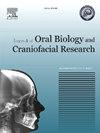tmd-e追踪器诊断颞下颌疾病的临床验证:可靠性和准确性评估
Q1 Medicine
Journal of oral biology and craniofacial research
Pub Date : 2025-06-02
DOI:10.1016/j.jobcr.2025.05.006
引用次数: 0
摘要
颞下颌关节疾病(TMDs)是一种影响颞下颌关节(TMJ)的肌肉骨骼疾病,通常导致疼痛、运动受限和关节声音。传统的诊断方法依赖于主观评估和成像,在可及性和成本方面存在局限性。TMD- e跟踪器是一种新型的非侵入性设备,用于量化TMJ振动并实时对TMD严重程度进行分类。本研究旨在评估TMD-E追踪器诊断tmd的准确性、可靠性和可行性,并将其结果与标准临床诊断方法进行比较。材料与方法使用TMD- e追踪器对24名参与者(12名TMD患者,12名健康个体)进行评估。该设备记录峰值振动频率和峰值发生时间,并与标准临床诊断措施进行统计比较。使用类内相关系数(ICC)评估检查者内部和内部的信度。采用p <独立t检验进行统计学分析;0.05认为显著。结果stmd患者的峰值频率(248±28 Hz)和延迟峰发生时间(1.65±0.38 s)显著高于健康人群(108±22 Hz, 0.95±0.21 s, p <;0.05)。该装置表现出良好的审查员内信度(ICC = 0.91)和审查员间信度(ICC = 0.89)。敏感性(89.5%)和特异性(92.3%)进一步证实了TMD-E追踪器的高诊断准确性。结论TMD- e追踪器是一种可靠、客观、临床可行的TMD诊断工具。它的实时振动分析为传统诊断方法提供了一个有希望的替代方案,尽管进一步的大规模验证是必要的。本文章由计算机程序翻译,如有差异,请以英文原文为准。
Clinical validation of the tmd-e tracker for diagnosing temporomandibular disorders: a reliability and accuracy assessment
Aim
Temporomandibular disorders (TMDs) are musculoskeletal conditions affecting the temporomandibular joint (TMJ), often leading to pain, restricted movement, and joint sounds. Traditional diagnostic methods rely on subjective assessments and imaging, which have limitations in terms of accessibility and cost. The TMD-E Tracker is a novel, non-invasive device designed to quantify TMJ vibrations and classify TMD severity in real time. This study aimed to assess the diagnostic accuracy, reliability, and feasibility of the TMD-E Tracker in detecting TMDs and to compare its findings with standard clinical diagnostic methods.
Materials and methods
A total of 24 participants (12 TMD patients, 12 healthy individuals) were evaluated using the TMD-E Tracker. The device recorded peak vibrational frequency and timing of peak occurrence, which were statistically compared with standard clinical diagnostic measures. Intra- and inter-examiner reliability were assessed using the Intraclass Correlation Coefficient (ICC). Statistical analysis was performed using independent t-tests with p < 0.05 considered significant.
Results
TMD patients exhibited a significantly higher peak frequency (248 ± 28 Hz) and delayed peak occurrence timing (1.65 ± 0.38 s) compared to healthy individuals (108 ± 22 Hz, 0.95 ± 0.21 s, p < 0.05). The device demonstrated excellent intra-examiner reliability (ICC = 0.91) and inter-examiner reliability (ICC = 0.89). The sensitivity (89.5 %) and specificity (92.3 %) further confirmed the high diagnostic accuracy of the TMD-E Tracker.
Conclusion
The TMD-E Tracker is a reliable, objective, and clinically feasible diagnostic tool for TMD assessment. Its real-time vibrational analysis offers a promising alternative to conventional diagnostic methods, though further large-scale validation is warranted.
求助全文
通过发布文献求助,成功后即可免费获取论文全文。
去求助
来源期刊

Journal of oral biology and craniofacial research
Medicine-Otorhinolaryngology
CiteScore
4.90
自引率
0.00%
发文量
133
审稿时长
167 days
期刊介绍:
Journal of Oral Biology and Craniofacial Research (JOBCR)is the official journal of the Craniofacial Research Foundation (CRF). The journal aims to provide a common platform for both clinical and translational research and to promote interdisciplinary sciences in craniofacial region. JOBCR publishes content that includes diseases, injuries and defects in the head, neck, face, jaws and the hard and soft tissues of the mouth and jaws and face region; diagnosis and medical management of diseases specific to the orofacial tissues and of oral manifestations of systemic diseases; studies on identifying populations at risk of oral disease or in need of specific care, and comparing regional, environmental, social, and access similarities and differences in dental care between populations; diseases of the mouth and related structures like salivary glands, temporomandibular joints, facial muscles and perioral skin; biomedical engineering, tissue engineering and stem cells. The journal publishes reviews, commentaries, peer-reviewed original research articles, short communication, and case reports.
 求助内容:
求助内容: 应助结果提醒方式:
应助结果提醒方式:


